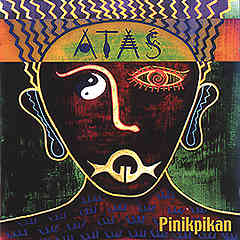"Atas"
Pinikpikan
| CD 68.821 |
 Pinikpikan, being diverse in musical styles and influences and in the use of indigenous instruments, patronizes and promotes everything indigenously Filipino. Given the dominance of the English language in developing countries such as the Philippines, Pinikpikan makes sure that its songs are sung in various Filipino languages, which, like any other language, carry with them cultural values as well as unique rhythmic and melodic patterns.
Pinikpikan, being diverse in musical styles and influences and in the use of indigenous instruments, patronizes and promotes everything indigenously Filipino. Given the dominance of the English language in developing countries such as the Philippines, Pinikpikan makes sure that its songs are sung in various Filipino languages, which, like any other language, carry with them cultural values as well as unique rhythmic and melodic patterns.
On track nr.1 KALIPAY one hears Gangsa (brass gongs) and tungatong (bamboo rhythmsticks) from the Cordilleras in Northern Luzon as the main instruments that envelope the whole song…a piece about happiness through dancing. The lyrics are a mix of languages spoken from North to South of the Philippine archipelago. A single word is uttered several times in languages such as Ilokano, Kapampangan, Bisaya, Bikolano, Tingguian, etc. The name of track nr.2 SINGKILAN derives from the word singkil which is a Maranao dance from Mindanao executed and played with bamboos. A main instrument used in this piece is the kulintang (brass gongs) which is also from Mindanao. On track nr.3 AUMOON you can hear the Hindu-Arabic influence that spread all over Mindanao especially among the Maranaos, Maguindanaos and Tausugs. Track nr.4 KAHIMANAWARI is based on an old Tagalog word, which means "God´s will be done," also "God willing". The central instrument is the kuglong, a two-stringed lute from Hindu-Arabic Mindanao. UNA KAYA (track nr.5) means literally translated "first [you] can". In the song, the two words are used like a mantra repeated over and again to motivate Indigenous Peoples to move on and succeed in life. The gabbang and chatting play very important roles in this piece. Origin: Southern Mindanao / Tawi-Tawi. Track nr.6 ANIWANA is Pinikpikan´s coined word for the phrase "Aniwanag ng Liwanag," which means "gleam of light." Brings out the best of our chants from North to South of the Philippines and on track nr.7 SAKAYAN you have funked up jungle sounds and rhythms with a jazzed-up Grace Nono. A Maguindanao 6/8 rhythm with the higalong (long steel stringed lute) as main instrument is the basisi of the song INA-NENE, a song about mother and daughter. "Ina" which means "mother" and "Nene" which means "girl-child". These two words are used with the same meanings in various Philippines languages. The CD closes with track nr. 9 SALIDUM-AY, which is the most popular traditional song (lullaby) of Indigenous Peoples living in the Cordillera mountain range located North of the Philippines transformed into a hypnotic dance groove using the gaklab (woodblock), gangsa (brass gongs) and tungatong (bamboo rhythm sticks). The words of this song have no particular meaning except for carrying the tune. It is sung in various tunes; lyrics are usually improvised on the spot if sung by one person.
